One of the most interesting facts about all the different kinds of fish that we share our planet with is that we still only have a tiny idea of exactly how many different species of fish there really are.
Scientists have identified and researched tens of thousands of species (including the 75+ popular fish that start with G), but they know that there are likely tens of thousands more they’ve yet to discover, they’ve yet to research, and that they’ve yet to get a chance to even look at.
Even more interesting, though, is that the overwhelming majority of fish on this planet live in the Pacific Ocean – our largest ocean, for sure, but also home to more than 70% of the different fish species under the sun.
20% of the world’s fish live in the Atlantic Ocean, another 8% in the Indian Ocean, and the rest live in the major rivers, streams, lakes, and ponds all over the planet.
To learn a little bit more about fish that start with the letter G you’ll want to check out the rest of this detailed guide!
Contents
Popular Fish That Start with G
Other fascinating and similar posts:
- Popular Fish That Start with D
- Popular Fish That Start With I
- Popular Fish That Start With N
- Popular Fish That Start With P
1. Garibaldi
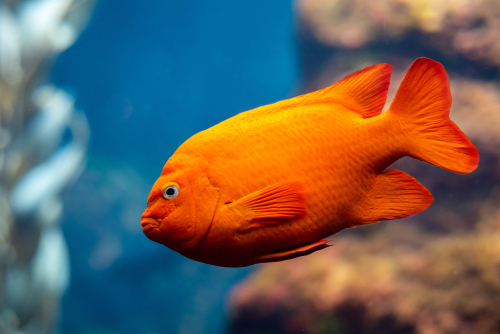
The state fish of California is small, foolishly colorful, but also pretty aggressive and territorial – and it’s also named after Giuseppe Garibaldi (a legendary Italian that fought for the reunification of Italy and was known for his incredibly bright red shirts).
While these fish can be found as far north in California as the Monterey Bay area, they are a whole lot more common in the warmer waters of the Channel Islands as well as Southern California in general.
These fish consume a pretty steady diet of algae and sponges, but they also aren’t afraid of eating tubeworms and other small animals in the water, either. It’s believed that the sponges they consume are a huge contributor to their bright, almost fluorescent color.
While these fish can be kept in aquariums it’s a good idea to make sure that they are kept alone. These fish are almost foolishly territorial, super aggressive, especially in the lead up to breeding season.
2. Goldfish
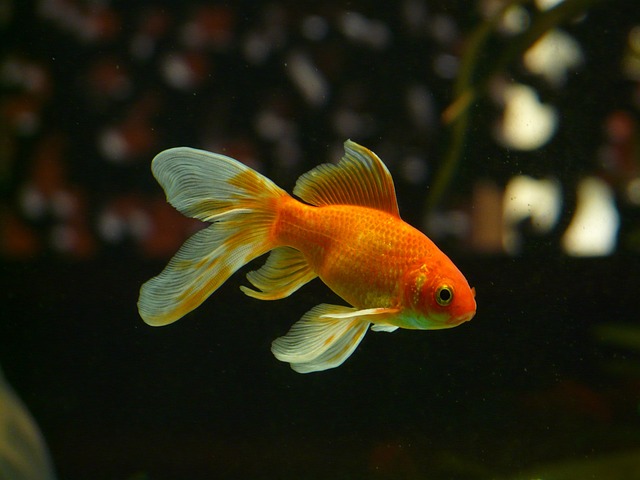
Perhaps the most iconic fish of them all, most everyone on the planet has heard of a goldfish – and a fair share of people worldwide have kept them as a pet, too.
Maybe the most popular of all the aquarium fish options, these fish are actually members of the Karp family and were selectively bred for color and size throughout Imperial China more than 1000 years ago.
About as easy to care for as an aquarium fish can get, these fish can be kept in tiny bowls so long as the water is frequently changed and they get plenty of food on a regular basis.
3. Ghost Knife Fish

About as unique a freshwater fish as you’re ever going to lay eyes on, these little beauties are the perfect addition to your aquarium if you’re looking for something outside the norm.
Found in tropical waters all over South America, these fish have a body that resembles an oversized machete. Early settlers in South America believed these fish to be the embodiment of people that had passed away violently, and that’s where the ghost part of the name originated.
If you looked at a ghost knife fish and thought it reminded you of an electric eel you wouldn’t be far off (even if these fish aren’t even close cousins).
That’s because the ghost knife fish does use electricity to find food, though the current that they put out isn’t quite strong enough to stun or even strike you.
4. Glass Catfish
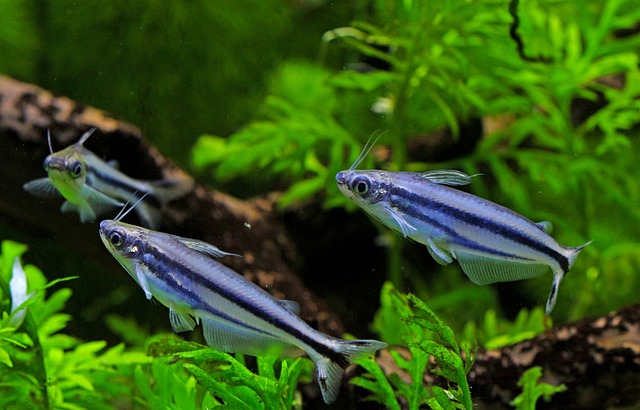
Glass catfish got their name from their transparent bodies, making them a wonderful addition to your aquarium if you’re looking for something quite a bit different than most options.
Originally found in southeast Asia, these fish are pretty simple and straightforward to keep so long as you maintain consistent tank conditions. Temperatures of between 75°F and 80°F are picture-perfect for these fish, with a pH of between 6.5 and 7.0.
It is important to have a moderate current running through your aquarium (at least 30 gallons of water, too).
If you can add vegetation and structure for these transparent fish to swim into should they get spooked their lead pretty happy and stress-free lives (living for eight years or longer on average).
5. Ghost Flathead

Ghost Flathead fish (sometimes called spiny Flathead fish) are a mostly scale lists, long, flat fish with a super wide head and eyes on the dorsal surface.
These fish live almost exclusively on the continental shelf at depths between 60 m and 1500 m (which contributes to their flat, elongated shape).
A carnivorous fish, they eat crustaceans and other fish that they can get a hold of and are said to have a pretty tasty flesh – though they are not fished commercially since they have so little flesh on them!
6. Galjoen Fish

The national fish of South Africa, the galjoen fish probably isn’t the first thing that people think of when they think of underwater creatures in this part of the world.
Especially not when South Africa has a huge great white shark population, a ton of beautiful and vibrant South African butterfly fish, and is also home to some of the largest sardine fisheries on the planet.
The galjoen, though, isn’t just an oddly shaped fish that calls South Africa home – it also really embodies a lot of what South Africa embodies, too.
Strong, resilient, and found nowhere else (at least not in the wild), this fish was made the national fish of South Africa by the wife of the legendary South African scientists of all time – JLB Smith.
His wife, Margaret Smith, wanted to make sure that a uniquely South African animal was picked as the national fish – a designation that was recognized by the government in 1992.
This fish was a huge part of early commerce in South Africa, with abundant schools of galjoen (the Dutch word of “galleon”) found just off of the Cape and nowhere else.
As popular a sport fish as there is, anglers the world over were coming to South Africa just for a chance to hook one.
Populations have declined rapidly since 1997, though, with a number of major conservation efforts being put in place by the South African government to bring this fish back to its former glory.
7. Ganges Shark
A species of shark that is dangerously on the verge of extinction, the Ganges shark is found exclusively within the Ganges River in India.
Technically classified as “Critically Endangered”, very little research has been conducted on these sharks simply because there are so few of them still in the wild.
In fact, the overwhelming majority of research done historically on these sharks has all stemmed from a singular example of the shark caught in the 19th century.
Modern researchers have been able to capture only 13 specimens, each and every one of them collected in 1996 on a number of expeditions led by the same organization.
New expeditions were led in 2010 as well as 2011, though both of them came up empty – even while Indian fishermen continue to report recognizing the shark still today.
The only 100% freshwater shark on the planet, these fish generally only grow up to about 31 inches in length and are carnivorous.
Sometimes these sharks are confused with bull sharks (they share a lot in common, especially in this part of the world), but are a completely distinct and separate species altogether.
8. Gar
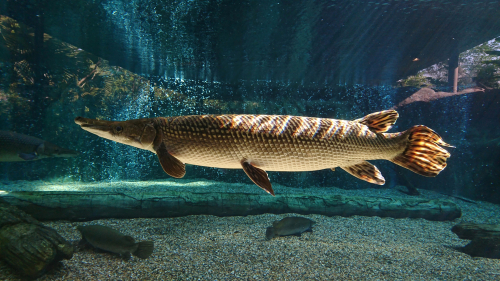
A prehistoric looking fish that actually comes from the Triassic Era (more than 240 million years ago), these predominantly freshwater fish have incredibly elongated bodies and almost armor-like scales that make them look a lot like underwater dinosaurs.
These fish have very long snouts, tons of large and razor-sharp teeth, and a serious similar kind of look to pike (though they are in totally different fish families).
All of these fish are pretty decent sized (growing to at least a few feet in length, on average), but the alligator gar is the largest of the bunch. It can grow to lengths of 6.5 feet or longer and way up to 100 pounds. 10 foot alligator gar have been in the wild before.
Believed to be the last of a family of bony fish that first really started to flourish during the Mesozoic Era, number of fossils showing gigantic gar from this time. Were found in Mexico and carbon dated to more than 157 million years ago.
Today, these fish are generally found in Texas, Louisiana, and along the eastern coast of Mexico. Though they can survive in saltwater (brackish water, really) they really like to live in the rivers and lakes that drain into saltwater.
9. Garden Eel
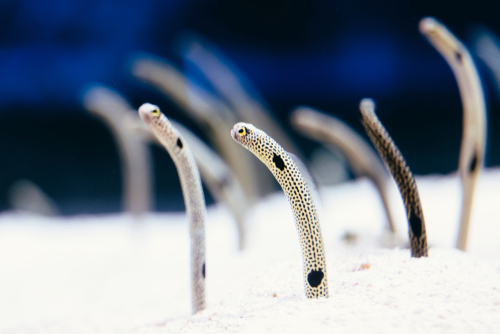
Part of the conger eel family, these fish are typically found in the warmer waters of the Atlantic Ocean (especially throughout the Caribbean) and in the East Pacific Ocean, too.
Tiny little eels (at least as far as eels are concerned), they love to burrow into the ocean floor and then pop their heads out. They get their name from the fact that they do this in little schools, leaving the ocean floor looking like they are growing out of a garden.
Super colorful, they come in a wide variety of different shades but almost always have a sort of phosphorescent look about them.
These fish generally reach a length of about 16 inches or so, but there have been extremely large garden eels discovered that grew up to about 4 feet in length.
If you want to keep garden eels in an aquarium you want to be sure that you not only have plenty of water for them (40 gallons at least), but that you also have a ton of sand for them to burrow into as well.
At least 6 inches of sand is recommended, but more is even better if you can swing it.
You also want to add a gentle current into your enclosure and do everything you can to eliminate aggressive tank “neighbors”. These eels don’t do well with confrontation.
10. Garpike
Now quite rare, the garpike was typically found in Mexico, Central America, as well as in the West Indies – and could even be found in stretches of North America (Eastern North America), too.
These fish are evolved to have a unique gas bladder, forcing them to rise to the surface every now and again to get rid of air that builds up in that bladder while refilling it with oxygen.
Because of this, these fish can live in toxic and even polluted waters that other fish would find completely intolerable – though they will drown if they aren’t able to access the surface reliably.
Shaped like a cigar, with a very long jaw and sharp teeth, these fish have scales (like the rest of the gar family) that are sort of like a bulletproof vest.
The scales are so hard, in fact, that Native Americans used large scales as arrowheads. Farmers even use to combine scales from large garpikes together to turn them into rudimentary shovels!
65 More Fish That Start with G

1. Gray Reef Shark
2. Gourami
3. Giant Raphael
4. Gombessa
5. Goblin Shark
6. Glowlight Danio
7. Gila Trout
8. Grouper
9. Giant Snakehead
10. Grunt
11. Gray Mullet
12. Glass Knifefish
13. Green Spotted Puffer
14. Gopher Rockfish
15. Giant Sea Bass
16. Greenling
17. Goby
18. Grayling
19. Giant Gourami
20. Great White Shark
21. Gurnard
22. Giant Danio
23. Ghoul
24. Geryi Piranha
25. Goatfish
26. Giant Puffer
27. Giant Danio
28. Gulper Eel
29. Ghost Knifefish
30. Grunion
31. Giant Whiptail Catfish
32. Ghost Shark
33. Grass Carp
34. Ghost Pipefish
35. Gamitana
36. Grenadier
37. Golden Shiner
38. Green Swordtail
39. Glassfish
40. Grunter
41. Gulf Menhaden
42. Guppy
43. Grunt Sculpin
44. Gudgeon
45. Gertrude’s Blue-Eye
46. Ground Shark
47. Guitarfish
48. Giant Brochis
49. Gulper
50. Gunnel
51. Greeneye
52. Giant Australian Glassfish
53. Goosefish
54. Graveldiver
55. Giant Gourami
56. Golden Loach
57. Giant Tanganyika Cichlid
58. Golden Dojo
59. Gar
60. German Ram
61. Gibberfish
62. Giant Pacu
63. Goldeye
64. Gizzard Shad
65. Golden Trout

Ian Sterling, founder of Fishlab.com, began his aquarium journey over 30 years ago, driven by a deep fascination for fish and their diverse personalities. His website, Fishlab.com, is dedicated to making fishkeeping accessible and enjoyable, offering beginner-friendly guidance, expert insights, and a community for aquarists to connect and share experiences.


